Piracy and Armed Robbery against Ships up to the third quarter of 2012
-Characteristics viewed in the IMB Report-
Hideshi Ueno,Research Fellow, Ocean Policy Research Foundation
Contents
On October 22, the International Maritime Bureau (IMB) of the International Chamber of Commerce (ICC) published a report on the incidents of piracy and armed robbery against ships noted in the world up to the third quarter of 2012 (January 1−September 30) through the Piracy Reporting Center(PRC)based in Kuala Lumpur. Below is a summary of the characteristics of the incidents of piracy and armed robbery against ships viewed from the IMB report (hereinafter referred to as Report) noted up to the third quarter of 2012.
Regarding the definition of Piracy and Armed Robbery against Ships, the IMB accepts the “definition of piracy” in Article 101 of the United Nations Convention on the Law of the Sea (UNCLOS). As for the armed robbery, the IMB accepts the definition of the “Code of Practice for the Investigation of the Crimes of Piracy and Armed Robbery against Ships” which was adopted by the International Maritime Organization (IMO) in November 2001.
1. Characteristics viewed from numbers and locations of the incidents (including attempted attacks)
The number of the incidents reported up to the third quarter of 2012 was 233 (352 during the same period in 2011), which shows a dramatic decrease. By the way, the number of 2011 was more frequent than that of any others since IMB has begun to monitor maritime attack cases in 1991, while the Table 1 indicates the maritime situation during up to the third quarter of these 6 years. Furthermore, as the Table 2 shows, of the 233, 149 (173 during the same period in 2011) were actual attacks. Of them, 24 (35 during the same period in 2011) were cases hijacked, and 125 (138 during the same period of 2011) were cases boarded. 448 crews were taken hostages, including the fact that 6 of them were killed at least.
Conversely, there were 84(179 during the same period in 2011) attempted attacks. Of them, 26 (90 during the same period in 2011) were cases fired upon, and 58 (89 during the same period of 2011) were cases attempted. However, the IMB is estimating that there are a great number of unreported cases apart from the reported cases, advising the shipping owners and captains of the ships to report all piratical attacks and suspicious movements of the crafts to the bureau.
Looking at the attacks during up to the third quarter in 2012 by location, of the 233, 153 attacks have occurred in the 6 locations below. Looking at the attacks in order of a higher frequency, there are 51 attacks in Indonesia, 44 attacks off Somalia including the Indian Ocean, 21 attacks in Nigeria, 13 attacks in the Red Sea, 13 attacks in the Gulf of Aden and 11 attacks in Togo. This trend shows a huge increase in the Gulf of Guinea in West Africa.
The number of incidents (attacks) in the Gulf of Aden, off Somalia (including the Indian Ocean), and the Red Sea in the surrounding waters of the “Horn of Africa” totals 70 (199 during the same period of 2011), which occupy a little less than the half of all, and it turns out that this area is frequent pirates occurrence zone. Especially, of the 70 attacks, 13 hijacked incidents (4 in the Gulf of Aden and 9 off Somalia including the Indian Ocean), 1 boarded incident (off Somalia including the Indian Ocean) were noted. In 217 crews who were taken hostage, 1 was injured and 2 were killed. As of the end of September 2012, 11 ships have been detained and 167 crews also taken hostages. Additionally while 21 crews are abducted on the land of Somalia, pulled up from sea, IMB estimates that more than 20 hostages have been detained for more than 30 months. Of 70 cases, 56 attempted attacks including 37 attempted cases (5 in the Gulf of Aden, 13 in the Red Sea, 19 off Somalia including Indian Ocean) and 19 fired upon cases (15 in off Somalia and 4 in the Gulf of Aden) are recorded.
According to the report, Somali pirates continue to threaten an extended geographical region, which covers from the southern part of the Red Sea in the west to 76 degrees East longitude and 25 degrees North latitude in Gulf of Oman to 22 degrees South latitude, and use hijacking vessels and dhows as their mother boat to attack sailing vessels. And this report indicates that using mother boats expand a possibility for Somali pirates to operate. In fact, there was not only 1 attempted attack in the Red Sea in the third quarter during July-September, when it is impossible for small boats to sail due to southwest monsoon.
According to the report, the decrease in the number of incidents in off Somalia is attributed to the deployment of navy aircrafts, the practical use of anti-piracy manual such as BMP (the Best Management Practices), the self-defense measures of vessels, the increase on employment of private armed guards such as PCASP (Private Contracted Armed Security Personnel), and the EU fleet’s attacks to the base of Somali pirates. IMB advises sailing vessels not to neglect the warning.
Other part, the situation in the Gulf of Guinea on the west coast of Africa is deteriorating. The number of incidents rise 34 from 30 during the same period of 2011 and the area is extended onto Togo. According to the report, while attacks are violent and well planned, armed pirates sometimes target gas oil and break electronic equipments and navigation systems of ships. Especially off Togo, the number of incidents mostly doubled 11 from 6 during the same period of 2011 and those include 3 hijacked cases, 2 boarded cases and 6 attempted cases. In off Nigeria, of 21 attacks, 4 hijacked cases, 9 boarded cases, 7 fired upon cases and 1 attempted case are reported. IMB indicates that not all navies in the Gulf of Guinea have the resources to fight piracy far out at sea.
As the Table 1 and the Table 2 show, in Southeast Asia, Indonesia recorded 51 incidents, which shows a dramatic increase from 30 cases in the same period of 2011 and annual 2011 total of 46. In Indonesia, the incidents have frequently occurred in Jakarta Tanjungpriok, Dumai, Belawan, Taboneo and Muara Jawa. But the most of incidents targeted anchored vessels by armed men with knives or hatchets in night. In other Southeastern countries, incidents are reported as follows, which are 2 in the Strait of Malacca, 8 in Malaysia, 3 in the Philippines, 6 in Singapore and 1 in South China Sea.
2. Characteristics viewed from activities
The Table 2 shows the status of attacks by location noted frequently in the areas in Asia and others up to the third quarter of 2012. The Table 3 shows the status of attacked ships, including the attempted cases by location.
According to these, the distinct feature of attacks by Somali pirates is discovered. All incidents including attempted occurred at time when vessels were streaming and the pirates tends to attack those with small boats from mother ship.
In Southeast Asia, many cases were boarded attacks and those occurred mostly at time when vessels were anchored. However, attacks which vessels were streaming also recorded 5 in Indonesia, 2 in the Strait of Malacca, 3 in Malaysia, 1 in Singapore, 5 in the Strait of Singapore and 1 in South China Sea. Of these, 3 were hijacked incidents, which were a hijacking fishing boat case in the Strait of Malacca and 2 hijacking tag boat cases in Malaysia and South China Sea.
Other part, up to the third quarter in 2012, ports and anchorages which were attacked more than 3 times are recorded at 11 different places and the number of attacks is totally 63. These are slightly fewer than those of the same period in 2011, which recorded 11 different places and 68 attacks.
The most places are Dumai in Indonesia and Lome in Togo (11 attacks), and the following are Chittagong in Bangladesh (8 attacks), Lagos in Nigeria (7 attacks), Belawan in Indonesia (5 attacks), El Dekheila in Egypt, Jakarta Tanjung Priok and Pointe Noire in Congo (4 attacks), and Batam and Taboneo in Indonesia and Abidjan in Cote d’Ivoire (3 attacks). No attacks are reported in Cotonou in Benin, which recorded 18 incidents during the same period in 2011.
In the types of ships attacked including attempted cases, the highest number is 46 bulk carriers and the following are 43 chemical tankers, 33 containers, 26 tankers, 16 product tankers, 13 tugs, 11 general cargos, 9 LPG tankers, 5 offshore tug boats, 5 offshore supply ships and 5 dhows. In Somalia, pirates attacked various kinds of ships, which are general cargo, bulk carrier, chemical tanker, product tanker, LPG tanker, LNG tanker, bunkering tanker, roll on and roll off cargo ship, container, fishing vessel, yacht, tug and dhow, and this report indicates that their attack tends to be ad hoc.
In flag states whose vessels attacked during January-September in 2012, of 233 attacks, the highest number is 39 vessels of Singapore and the following are 37 of Liberia, 36 of Panama, 16 of Marshall islands, 13 of Hong Kong and 12 of Bahamas. And no Japanese registered vessels are reported (1 attack was recorded in the same period in 2011).
Other part, focusing on countries where victim ships controlled/managed, it is obvious that the highest number of 58 vessels was given to Singapore. The following are 33 of Germany, 26 of Greece, 11 of Hong Kong and UK, and 9 of India. The number of Japan was 6.
3. Types of violence to crew and peculiarities of weapons used
Looking at the damages to crews, as the Table 4 shows, the most of cases are increasingly occupied by situations which crews were taken hostages since 2008. But the number of people who were involved in such cases during up to the third quarter in 2012 recorded 458. Moreover, as the Table 5 shows type of violence to crew by location, the number of hostages recorded 38 in the Gulf of Aden and 179 in Somalia, which is nearly the half of total 458, and Somali pirates tend to take hostages and demand a ransom. Addition to the fact that the number of killed recorded 4 in Nigeria and 2 in Somalia, the number of abducted recorded 7 in Nigeria, which indicates a violent tendency in Nigeria.
Focusing on the Table 6 which shows types of arms used by pirates during attacks January-September 2007-2012, it is obvious that guns and knives have remained mostly major arms for pirates. Additionally, as the Table 7 shows the types of arms used by pirates by location, the number of incidents in which guns were used recorded 12 in the Gulf of Aden, 6 in the Red Sea, 33 in Somalia, which were mostly conducted by Somali pirates. This indicates that how dangerous Somali pirates armed with AK-47 rifles and RPG-7 rocket weapons are. The number recorded 21 attacks in Nigeria and 5 in Togo, which shows violent characteristics of pirate attacks frequently using guns in the waters in the Gulf of Guinea.
In the cases of Southeast Asia, knives are more frequent than guns. Of a total of 56 attacks in which knives were used, Indonesia overwhelmingly recorded 22 attacks. Furthermore, the cases of “Not stated” were recorded 79 in all the 233 incidents and Indonesia recorded the highest number 21. The following are 11 attacks in Somalia and 7 in the Red Sea.
Table 1: Trends of incidents (including the attempted attacks) that occurred frequently in Asia and other areas up to each third quarter of the recent six respective years
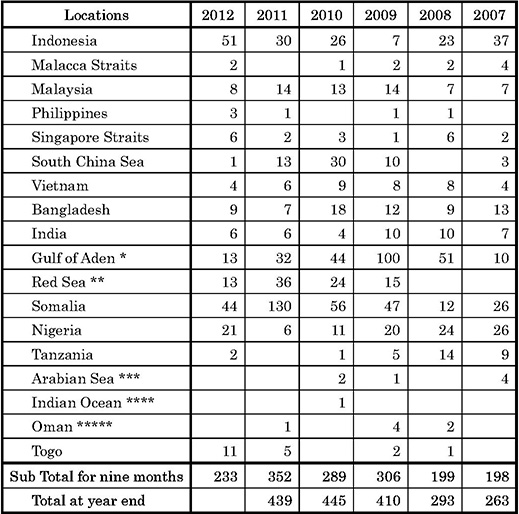
Source: Made from Table 1 in the Report up to the third quarter of 2012, pp.5-6. The total of the incidents covers all areas targeted in the Report.
Remarks: *; Gulf of Aden, **; Red Sea, ***; Arabian Sea, ****; Indian Ocean, *****; Oman – All of the above attacks are attributed to Somali pirates.
Table 2: Status of attacks noted frequently in areas in Asia and others up to the third quarter of 2012
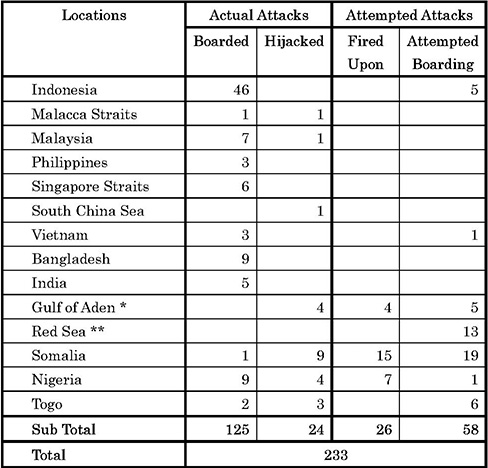
Source: Made from Table 2 in the Report up to the third quarter of 2012, p. 8. The total of the incidents covers all areas targeted in the Report.
Remarks: *; Gulf of Aden,**; Red Sea -All of the above attacks are attributed to Somali pirates.
Table 3: The status of the ships during attacks by location noted up to the third quarter of 2012
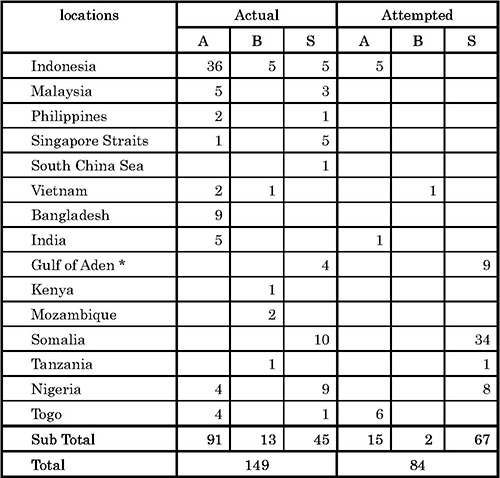
Sources: Made from Table 4 and Table 5 in the Report up to the third quarter of 2012, pp. 9-10. The total of the incidents covers all areas targeted in the Report.
Remarks: A = Anchored, B = Berthed, S = Steaming *; Gulf of Aden is attributed to Somali pirate.
Table 4: Types of violence to crew up to the third quarter of a year throughout the recent six years
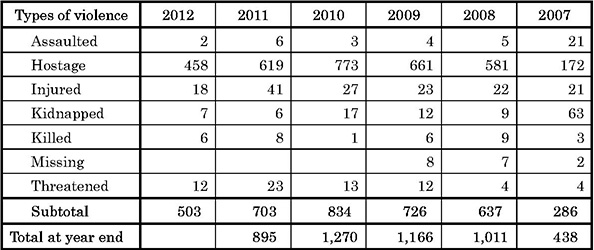
Source: Made from Table 8 in the Report up to the third quarter of 2012, p. 11.
Table 5: Status of violence in major pirate-infested areas up to the third quarter of 2012
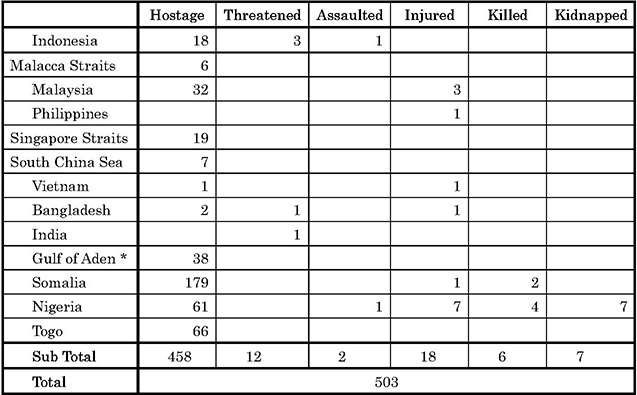
Sources: Made from Table 9 in the Report up to the third quarter of 2012, pp. 11-12. The total of the incidents covers all areas targeted in the Report. *; Gulf of Aden is attributed to Somali pirate.
Table 6: Types of arms used by pirates during all attacks up to the third quarter of a year throughout the recent six years
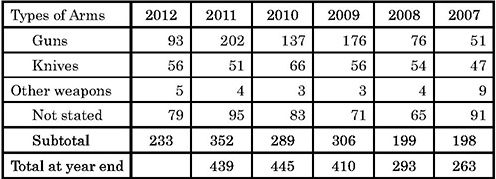
Sources: Made from Table 6 in the Report during the first half of 2012, p. 11.
Table 7: Types of Arms in major pirate-infested areas up to the third quarter of 2012
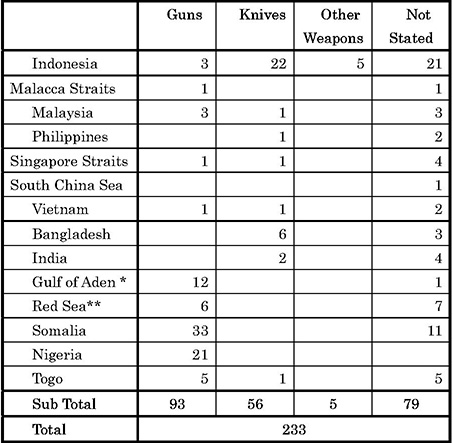
Sources: Made from Table 10 in the Report up to the third quarter of 2012, pp. 12-13. The total of the incidents covers all areas targeted in the Report.
Remarks: *; Gulf of Aden,**; Red Sea -All of the above attacks are attributed to Somali pirates
From “Intelligence Analysis (October 2012)”
関連記事
